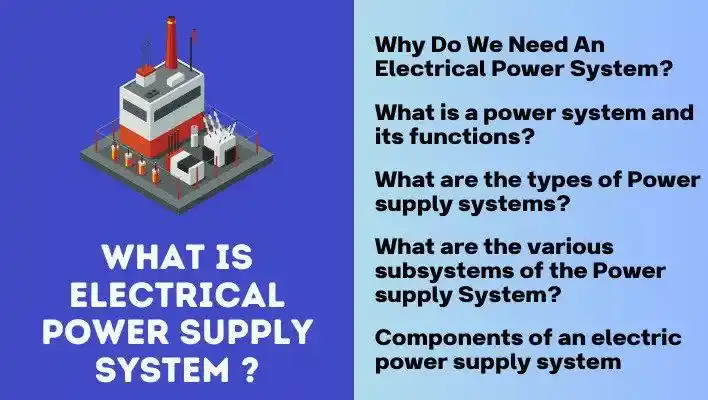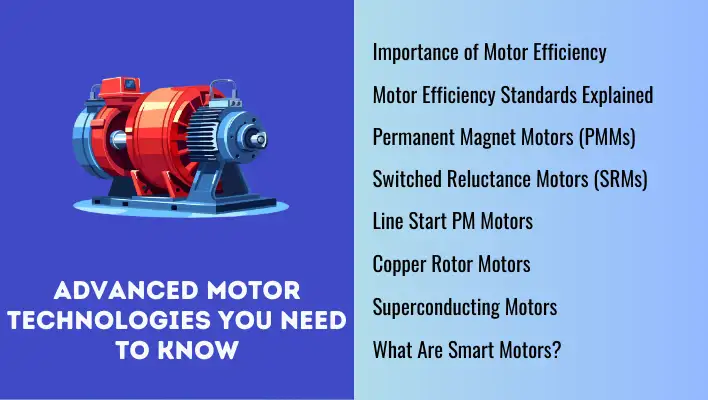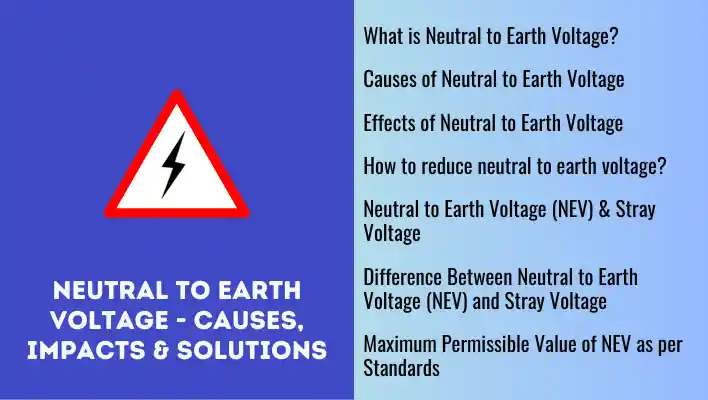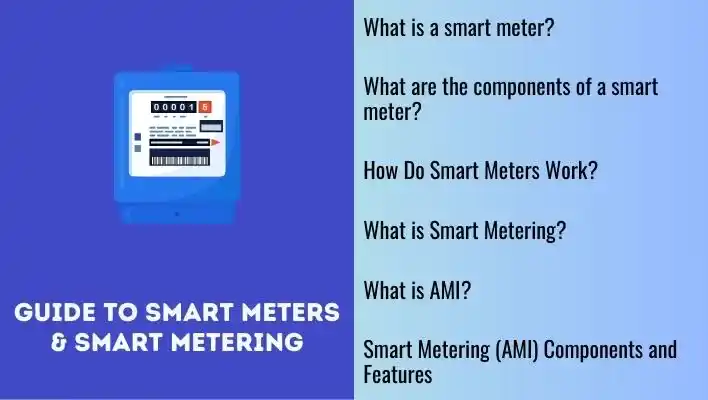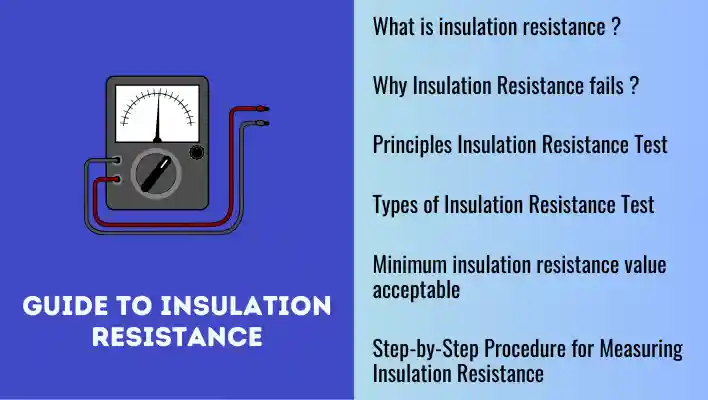Electric power supply systems are complex networks that are responsible for generating, transmitting, and distributing electricity. They are critical to modern society, as electricity is essential for everything from lighting and heating to running machines and powering electronic devices. In this article, we will explore the functions, types, and characteristics of electric power systems, providing you with a comprehensive understanding of this important topic.
Also Read: Types of High Voltage Circuit Breakers | Explained
Why Do We Need An Electrical Power supply System?
Electricity is a fundamental need in modern life, and the electrical power supply system is the backbone that ensures a continuous supply of electricity. The importance of the electrical power supply system lies in its ability to provide electricity to end-users for various purposes.
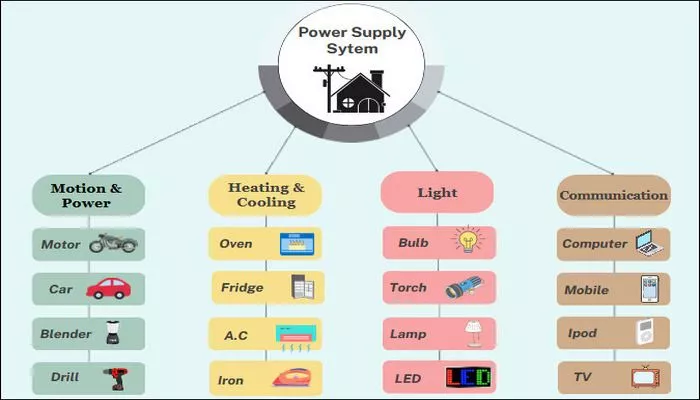
- The most obvious reason for an electrical power supply system is to provide electricity for homes, businesses, and industries. It powers appliances, lighting, heating, cooling, and a wide range of electronic devices essential for daily life and economic activities.
- Industries rely heavily on electrical power for various processes, manufacturing, and operations. Many industrial machines and equipment require a stable and reliable power supply to function efficiently.
- Hospitals and healthcare facilities depend on electricity to run life-saving equipment, medical devices, and provide necessary lighting and heating. A consistent power supply is critical for patient care and medical procedures.
- The functioning of communication networks, data centers, and information technology infrastructure relies on a continuous and reliable power supply. Interruptions in power can lead to data loss, communication breakdowns, and disruptions in various services.
- Electric power is increasingly becoming a significant player in transportation through electric vehicles (EVs) and electrified public transportation systems. Charging infrastructure and grid support are essential for the widespread adoption of electric vehicles.
- Agriculture relies on electrical power for irrigation systems, machinery, and other equipment. Precision farming techniques often involve the use of electrically powered devices.
- Reliable electrical power is a key driver of economic development. It enables industries to operate efficiently, encourages technological advancements, and attracts investment. Access to electricity is often seen as a crucial factor in a region’s economic growth.
- Power is essential for social infrastructure such as street lighting, water treatment plants, and public services. It contributes to public safety and the overall well-being of communities.
- Electricity enhances our quality of life by powering entertainment devices, household appliances, and various conveniences. It enables us to stay connected, informed, and entertained.
In conclusion, the electrical power supply system is an essential part of modern living, and it is necessary for almost every aspect of our daily routine and services that are integral to our society’s functioning and development.
Also Read: Smart Grid | The Ultimate Guide
What is a power supply system and its functions?
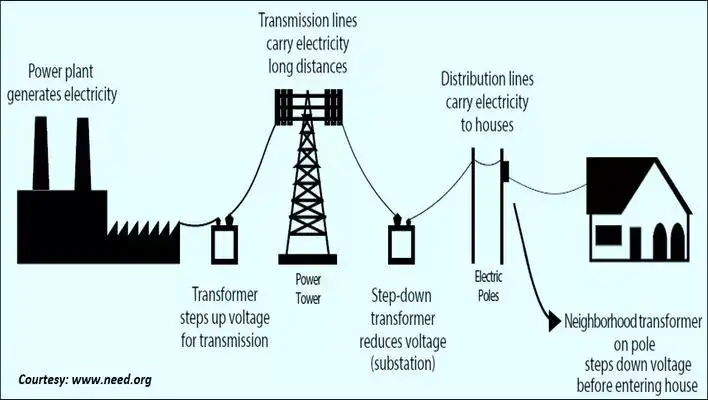
An electrical power supply system can be described as an assembly of various essential electrical equipment located at different strategic positions, all working continuously and collaboratively to provide cost-effective and uninterrupted electrical energy supply to consumers.
It’s not like water or gas that you can store up for later use.
When you turn on your lights, the energy is generated, sent through transmission lines and delivered to your home right when you need it.
A power system can be AC and DC with an overhead or underground system.
For AC transmission, three-phase three-wire systems are employed and for AC distribution three phase four-wire systems are used.
The most important function that an Electric Power supply system has to perform are,
- Transmitting electric supply at specified voltage and frequency.
- Controlling and managing direction and magnitude of power through lines.
- Ensuring stable transmission links with associated AC networks.
- Managing and controlling voltage at sending and receiving ends of transmission lines.
- Managing load scheduling and load shedding.
- Facilitating alternate transmission paths in case of breakdown.
- Providing protection from faults, identifying faults and maintaining power supply.
- Managing transmission losses with control over reactive power compensation.
What are the types of Power supply transmission systems?
There are three main types of electrical power supply systems:
AC (alternating current) power transmission systems

AC (alternating current) power transmission systems are a common way to transmit electrical power over long distances. These systems typically include generators, transformers, transmission lines, and distribution networks.
The reason AC power is used is that it can be easily stepped up or down in voltage with the help of transformers, making it efficient for transmitting and distributing power over long distances.
The frequency of these systems is usually 50 or 60 hertz, depending on the region.
AC power transmission systems are widely used worldwide, and they’re the most prevalent way of transmitting electrical power.
DC (direct current) Transmission systems
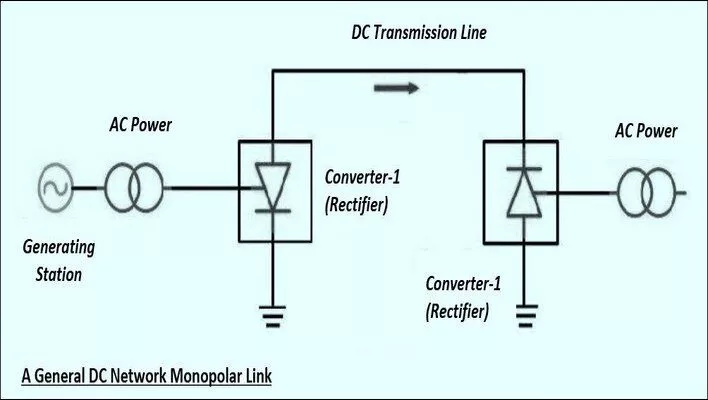
Three-phase AC power is the most widely used system for generating, transmitting, distributing, and utilizing electrical power. However, there is now growing interest in high-voltage direct current (HVDC) power transmission as a viable alternative to extra high voltage AC (EHV-AC) transmission systems.
In HVDC systems, AC power is converted into DC power at one end using thyristor-based rectifiers. The DC power is then transferred to the other end of the transmission line.
At the receiving end, the DC power is converted back into AC power using inverters and fed into the local AC system. Although DC transmission systems are less common than AC systems, they are still used in some specialized applications.
Also Read: What is interconnected power system or grid?
Hybrid Transmission systems
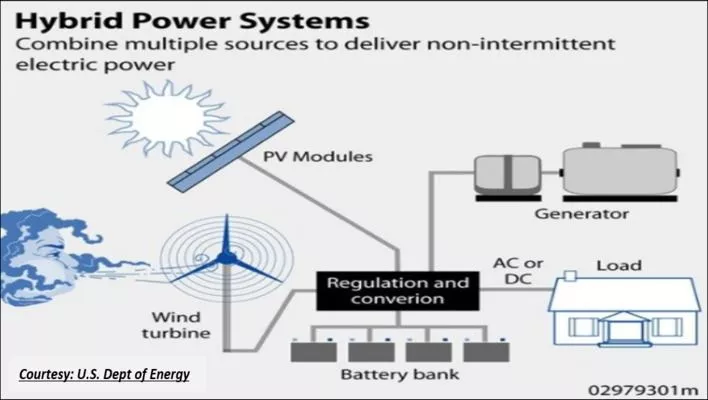
A hybrid power supply system is a combination of two or more types of power supply systems.
It typically consists of a combination of renewable energy sources such as solar, wind, or hydroelectric power, along with conventional sources such as diesel generators or grid-connected power.
The hybrid power supply system is designed to provide reliable and uninterrupted power supply while minimizing the environmental impact and reducing the dependency on fossil fuels.
The system is usually automated and can switch between the different power sources based on the availability of the energy sources and the power demand.
What are the various subsystems of the Power supply System?
A power supply system is made up of several subsystems and components that work together to efficiently transmit power over long distances.
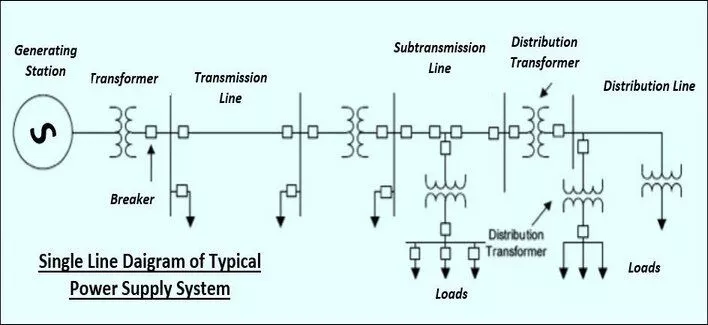
If any of these subsystems fail to perform their task, the entire system can fail. That’s why every subsystem is important for the proper functioning of the power system.
The subsystems are as follows,
- Generation
- Transmission
- Distribution
- Loads
- Protection & Control
Generation
Electricity is generated in large facilities known as generating stations or power plants.
These power plants consist of an electric generator coupled to a prime mover.
The sources of energy used for generating electric energy are classified into three main categories:
- Fossil fuels such as coal (including lignite and peat), oil, and natural gas.
- Renewable energy sources like hydro, wind, and solar.
- Nuclear energy obtained from uranium or plutonium.
These three categories of energy sources play a significant role in producing the electricity that powers our homes, businesses, and industries.
In the current power system scenario, there are four types of power plants,
- Thermal power plants.
- Hydro-power plants.
- Nuclear power plants.
- Non conventional (Renewable).
In thermal power plants, coal, oil and natural gas are a source of primary energy.
Chemical energy in coal → Heat energy in steam → Mechanical energy in turbine → Electrical energy.
Hydel power station employs the head and volume of water as a primary source.
Potential Energy of water → Kinetic Energy → Electrical Energy.
In nuclear power plants, uranium and plutonium is used as the primary source for controlled nuclear fission.
Nuclear Fission → Heat energy in steam → Mechanical energy in turbine → Electrical energy
The generating Stations produce power at varying voltage levels from 11KV to 30 KV.
Transmission Subsystem
In the electrical power supply system, the transmission system is one of the most essential subsystems.
The transmission lines are required because,
- They are responsible for bulk power transfer from generating stations up to the main transmission network.
- For an interconnected power supply system.
- For transfer of power from transmission (EHV) lines to the distribution network.
The point to note here is that, the power transmitted over transmission lines is proportional to the square of the transmission voltage.
Hence it is desirable to have the highest transmission voltage.
Also another reason for increasing the transmission voltage is that the conductor size decreases with the increase in voltage, thus it becomes economical to carry power over long distances.
The power generating stations produce electricity at relatively low voltages between 11KV to 30 KV. This voltage is not suitable for long-distance transmission. Therefore, we use step-up transformers near the generating stations to increase the voltage and reduce the current.
The extra high voltage (EHV) of 765KV-400KV is transmitted over long distances to remote EHV substations located outside the cities.
The EHV substations use step-down transformers to reduce the voltage to 220KV-132KV high voltage (HV).
From there, the energy is transmitted to high voltage substations which come under the Distribution subsystem within the cities.
Also Read: Importance of Power Transmission Lines | Explained
Distribution Subsystem
In the distribution subsystem the voltage is further reduced at the HV substations to 66KV-33KV and sent over to distribution substations.
The part of the transmission system that connects the high voltage substations to the distribution substations is known as the sub-transmission system.
This part of the transmission system is where many heavy industrial consumers are connected.
At the distribution substation, the voltage is brought down, and multiple distribution lines proceed from each distribution substation as overhead or underground lines.
These lines allocate energy to the urban and suburban areas. The standard voltages on the distribution side are 66kV, 33 kV, 22 kV, 11 kV and 400/230 volts, besides 6.6 kV, 3.3 kV, and 2.2 kV.
Load
Load refers to the total amount of power being used by all the consumers connected to the distribution network.
This includes the power lost during transmission and distribution, which needs to be reimbursed.
There are three main types of loads in the power system: Industrial, Residential, and Commercial.
Industrial loads typically consist of rotating machines and lighting, and they rely heavily on the voltage and frequency of the power supply.
Residential and commercial loads, on the other hand, are mostly dependent on voltage and include appliances used for heating, cooling, and lighting.
The load subsystem of an electrical power system has several important terms that are used to define and regulate it.
These include the load curve, daily and annual load factor, diversity factor, utilization factor, and plant factor.
Let us try to understand these terms in short,
- Load Curve: The load curve refers to the graph of the variation of load demand over time. It helps in determining the maximum and minimum load requirements and the time duration for which they occur.
- Daily and Annual load factor: The daily load factor is the ratio of the average load during a 24-hour period to the peak load during that period, while the annual load factor is the ratio of the total energy consumed in a year to the energy that would have been consumed if the load was always at the peak level.
- Diversity Factor: It is the ratio of the sum of individual maximum demands to the peak demand of a group of consumers. It is used to account for the fact that not all consumers demand the maximum load at the same time.
- Utilization Factor: It is the ratio of the average load to the maximum demand of a system or component and used to evaluate the degree of utilization of a system or component.
- Plant Factor: Finally, the plant factor is the ratio of the actual energy generated by a power plant to the maximum energy it could have generated during a given period. It helps in evaluating the performance and efficiency of a power plant.
Overall, these terms help in regulating and maintaining the load subsystem of an electrical power system to ensure efficient and optimal utilization of the available resources.
Protection and Control
Just like any other system, the power supply system network is prone to faults.
These faults can cause power supply disruptions and cause significant damage to the equipment connected to the network.
In severe cases, they can even pose a danger to the people working in the operation and maintenance of the network.
To mitigate these risks, it’s vital to have a robust protection system that is seamlessly integrated into the power system design.
This involves installing protective devices like relays all over the power system network to detect any anomalies and take prompt corrective actions.
This proactive approach can prevent the occurrence of faults altogether or minimize their impact and guarantee the secure and dependable operation of the power system.
Also Read: Understanding Conventional Power Plants – A Detailed Exploration
What are the components of an electric power supply system?
Electric power supply systems consisting of various subsystems include a variety of components that work together to ensure the safe and reliable operation.
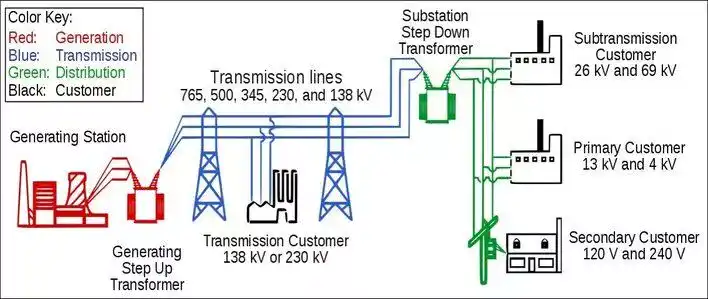
Here are some of the main components of an electric power supply system:
- Power generation equipment: This includes the equipment used to generate electricity, such as generators, turbines, and boilers. The type of generation equipment used depends on the type of power plant, such as a coal-fired plant or a wind farm.
- Transformers: Transformers are used to increase or decrease the voltage of electricity as it moves through the electric power system.
- Transmission lines: High-voltage transmission lines are used to transport electricity over long distances. These lines are typically made of metal conductors and supported by large towers or poles.
- Distribution lines: In order to supply electricity to homes and businesses, distribution lines with lower voltage are employed. These lines can either be installed with overhead conductors on poles or through underground cables.
- Substations: Substations are used to switch, control and protect the flow of electricity in the electric power system. They typically include transformers, switchgear, and other equipment.
- Switchgear: Switchgear is used to control the flow of electricity in the electric power system. It includes circuit breakers, disconnect switches and other devices that are used to protect the system from overloads and faults.
- Protective relays: Protective relays are deployed in the electric power system to identify faults and activate protective devices like circuit breakers, which isolate the fault to prevent further damage.
- Control systems: Control systems are used to monitor and control the flow of electricity in the electric power system. They include computer systems, sensors, and other devices that are used to optimize the performance of the system.
What are the characteristics that define the functioning of a power supply system?
The characteristics that define the functioning of a power system are,
- Voltage Management: All the equipment is designed for working to their full capacities at a rated voltage. If there is a sudden voltage fluctuation it can lead to decrease in efficiency or equipment failure.
- Reliability: One basic requirement of any consumer is to receive uninterrupted power supply. For an industrial consumer the loss is huge due to failure of power supply. The expense of idle labor and machinery is far greater than what an industrial consumer pays for electricity. Essential systems such as hospitals need uninterrupted power supply or there could be loss of lives. Thus continuous supply is the necessity and its duty of electric utilities to provide it unhindered.
- Frequency: All the rotating machines and electric devices work on fixed frequency. If the frequency is not maintained constant the motors and many household devices will not run at its optimum efficiency. Thus losses to the industrial as well as domestic consumer.
- Maintaining the Sine Wave: The electric utilities should maintain sinusoidal waveform while supplying alternating voltage to consumers. If the waveform is not maintained as required, harmonics present in the system would cause adverse effects on the connected machinery.
- Induction Interference: Overhead power lines and underground cables should have independent paths. They should not be encamped with communication cables of telephone and data. Such intrusion causes induction interference which leads to failure of communication lines.
- Power factor: Consumers having inductive loads and not maintaining power factor close to unity should be penalized. The loads of low power factor require more power from the utilities thus overloading the generator. It also produces large voltage drops in the line voltages.
What is the role of State Electricity Boards (SEBs)?
State Electricity Boards (SEBs) are essential players in the power generation, transmission, and distribution sectors. Below are some of their key functions.

- The SEBs are in charge of keeping an eye on the entire process of generating, transmitting, distributing, and supplying electricity in the state.
- The board also decides the tariff for the electricity generated, transmitted, and distributed in the state.
- Board ensures that the tariff is fair and transparent, and it encourages competition in the market.
- Board sets the terms and conditions for buying and selling electricity among different entities in the state.
- The board is responsible for maintaining reliable and good quality of electricity supply in the state.
- They also undertake initiatives to promote energy efficiency and conservation, as well as the use of renewable sources of energy.
- Encouragement is given for the use of renewable sources of energy like solar and wind power in the state.
- They listen to the public’s opinion by holding public hearings on matters related to the electricity industry in the state.
- SEBs protect consumers’ interests by providing mechanisms to address complaints and disputes through grievance redressal.
- The SEBs works with the Central Electricity Authority to ensure the smooth functioning of the electricity industry in the state.
Overall, the role of SEBs is to ensure that electricity is available to everyone, regulate tariffs, protect consumer interests, and promote sustainable energy practices.
Summary
The subject of the electrical power supply system encompasses the essential infrastructure responsible for generating, transmitting, and distributing electrical power. It explores the functions, types, and components of power systems, emphasizing their critical role in meeting the energy needs of modern society. The discussion often includes subsystems and characteristics defining effective power system operation, shedding light on the intricate network that ensures a reliable and efficient supply of electricity. Additionally, the role of entities like State Electricity Boards is examined in managing and regulating power distribution.

